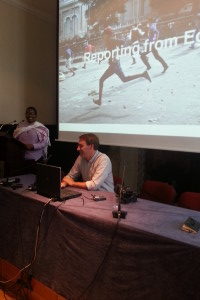by Kristy Dinsmoor, United States of America
Today our guest speaker, photojournalist Keith Lane, gave us an appreciation for the invisible people behind the  scenes who put themselves at risk (in more ways than one), in a search for truth. But “truth” is hard to identify. Even with the best of intentions on the part of the photographers behind the news, there are writers, editors, news agendas, and personal interpretation clouding the lenses by which we see the world.
scenes who put themselves at risk (in more ways than one), in a search for truth. But “truth” is hard to identify. Even with the best of intentions on the part of the photographers behind the news, there are writers, editors, news agendas, and personal interpretation clouding the lenses by which we see the world.
Adding a wave of considerations, Mr. Lane’s thoughts and stories allowed us to better understand how news photographers are an integral part of the news who have to have a personal passion, investment, and commitment to their stories. First, photographers like Mr. Lane often work freelance, meaning they might not get paid unless they deliver a photo which a news source likes. In this way they compromise their own financial security. Second, to capture the news we want to see, the news that sells, they often put themselves in harms way, physically in the midst of conflicts. Even in what appears to be a non-violent situation, many people are wary of cameras and outsiders, which creates discomfort for both them and the photographer.
We follow the news blindly assuming we are becoming informed. While we may be more informed about a certain part we don’t question or know if we’re getting the full story. Personally, I had not questioned the role a photographer plays in slanting our news. Many stories are supported by or built upon images. The choices of images captured, and subsequently chosen for publication, greatly determine what the public understands.
This brings up many considerations; such as do we assume all photojournalists are equally in search of the truth? Do we trust the various news outlets to not follow an agenda? Of course, if we are being honest we can recognize that there are different motivations for certain information to be shared over others.
As development and peace workers, hopefully we all understand the importance of information. If we have a true commitment to our work, it requires us to confront ourselves with all perspectives. Aside from some great stories, fantastic photos, and a growing appreciation for those who often go unrecognized, what today’s lessons have prompted is the question of how we, as professionals, as caring individuals, and as consumers, can support the quest for truth.
Searching for what is the “truth” will likely always be a work in progress. While I’m not sure I have an answer, I think it is a question worth asking ourselves. The closer we get to an answer, the more we can honor both the work of people like Mr. Lane and our own need for well rounded information to help guide the wisdom behind our work.

